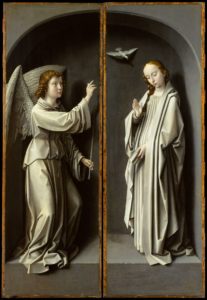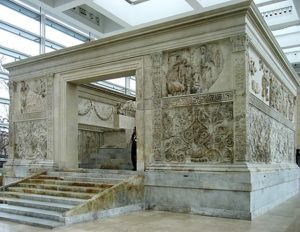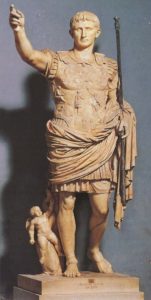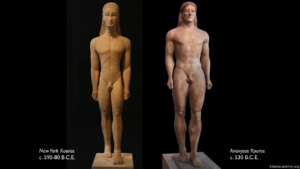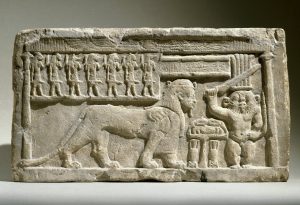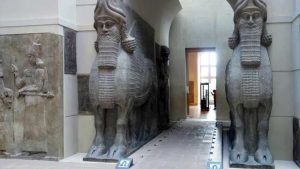The Men-Centered Society & its Relationship to the Human Body
I. (1-2 Paragraphs) Thesis Statement: This paper will explore the development of the realistic and idealized human body as it coexists with the philosophy of Humanism; this artwork begins to exist because of the shift from a God-centered society, into a men-centered society. In other words, the Greek philosophy of humanism reformed society into a man’s world rather than a religious world. This paper will also attempt to explain the “regression” of the mimetic idealized human body during the resurgence of cult religions.
II. (Historical Influences: 2200-2152 B.C-5th Century):
A.The Old Kingdom Male Body:
Title: Statue of Tjeteti as a young man
Artist: Unknown
Museum: The MET

In the Old Kingdom, the artwork was much more abstracted, with larger eyes and hands. The body is not as emphasized; in other words, lacking muscles. They used the eyes and hands as religious symbols (supplication).
B. Archaic (6th B.C) Male Body:

Title: Bronze youth
Artist: Unknown
Museum: The MET
C. The Classical Era (late 5th century B.C)
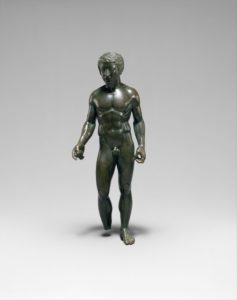
Title: Bronze youth
Artist: Unknown
Museum: The MET
Already from one century to the next the body becomes much more muscularized, and idealized. This shows the shift of a God-centered society into a humanism based civilization.
- The Met’s Heilbrunn Timeline of Art History, www.metmuseum.org/toah/ht/04/eusb.html.
“Following a period of sporadic incursions and large movements of people, demographic and economic changes in the eighth century B.C. lead to overseas colonization, spreading Greek language and culture across the Mediterranean and Black seas.”
This statement alone shows the development and inculcation of the Greek philosophy of humanism. This sculpture alone shows how this sporadic time inculcated this philosophy and in turn changed the image of the body by evolving into realistic pieces of artwork. The classical piece will show the further development of anatomical realism of the human body.
- Dr. Steven Zucker and Dr. Beth Harris, “Anavysos Kouros,” in Smarthistory, December 15, 2015, accessed December 10, 2018, https://smarthistory.org/anavysos-kouros/.
This is the most prominent piece of artwork that began the process into the realistic and idealized human body. The desire to improve began here or is widely known to have started with this art piece.
III. Hellenistic Period:
A. Early Hellenistic
Title: Terracotta relief probably from a funnel vase
Artist: Unknown
Period: Early Hellenistic; late 3rd–early 2nd century B.C
Museum: The MET
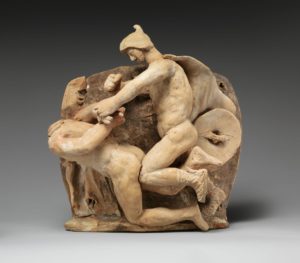
This statue also shows the importance of the body using two nude males, one most likely a Gaul and the other Greek, fighting. This fight combats the idea of the essence of Greek humanism; the struggle and dominance of man, especially the civilized greek.
B. Hellenistic
Title: Terracotta statuette of a veiled woman
Artist: Unknown
Period: Hellenistic; 2nd century B.C.
Museum: The MET
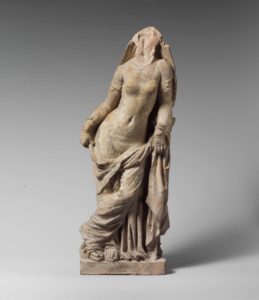
IV. ca. 1000-1400
A. 1175-1200
Title: Virgin and Child in Majesty
Artist: Unknown
Period: ca. 1175–1200
Museum: The MET
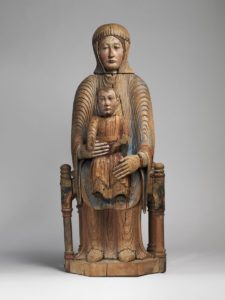
The shift of humanism towards a God shift society results in the abstracted form of the human body. Rather than alluding to the earthly, the heavenly is inferred through the abstract.
B. ca.1230
Title: Christ Enthroned
Artist: Unknown
Period: ca. 1230
Museum: The MET

This painting is to reiterate the shift religious status, resulting in abstracted human forms to allude to the heavenly. In other words when God is the center of civilization the body image is no longer realistic or idealized, but almost despised and forgotten.
- The Met’s Heilbrunn Timeline of Art History,
https://www.metmuseum.org/toah/ht/07/euwf.html
“Between 1000 and 1400, the kingdoms of the Franks, divided among many leaders, become the kingdom of France, which emerges under the Capetian dynasty as one of the most prosperous, powerful, and prestigious in Christendom.”
The change of religious state and political state influence the change of realistic and idealistic body images to an abstracted style, retracting to iconographic works similar to Egyptian worship statues. This alone proves that the philosophy returns to a God-centered society, where man is not as important in this time compared to the of the Greek democracy.
“The expansion of royal authority is halted in the fourteenth century by an economic crisis, the loss of a third of the population to the plague, and, from 1337, constant military conflict with the English”
Also interestingly enough, the return of the realistic and idealized body is after an economic crisis and the Bubonic plague. Men and women are suffering and because of this incomprehensible suffering, they become skeptical of a God. In other words when the need to return to a humanistic mentality arises the art changes with it. In short, when this need arises the Renaissance epoch began.
V. The Renaissance
A. Protestant Reformation
- Raphael M. Huber. (1941). Recent Important Literature regarding the Catholic Church during the Late Renaissance Period, 1500-1648. Church History, 10(1), 3-37. Retrieved from http://www.jstor.org/stable/3160724
The reason this article is so important because a common argument to my thesis would be:
During the Renaissance, Catholicism was very prominent, and yet the body image is highly idealized and realistic in the artwork. Well here is my point, the realistic and idealized body makes a comeback for two reasons; one is to give the Christian hope of heaven on earth; two, is because the church became extremely wealthy. The second point is important, the Protestant Reformation was because of the accusation that the Church’s distribution of wealth to create prominent and monumental Renaissance artwork was one of the many corruptions. Also, the use of the Catholic Hierarchy was another form of corruption. This hierarchy can be argued to be extremely narcissistic and places men in the middle of this societal circle once again; and not just any man but the Papal and clergy members. God was no longer in the center of this circle, but money was (money only serves man in order to survive).
B. Secular Government; Man-centered society
- Rule by Natural Reason: Late Medieval and early Renaissance conceptions of political corruption. (2012). In Barcham M., Hindess B., & Larmour P. (Eds.), Corruption: Expanding the Focus(pp. 53-72). ANU Press. Retrieved from http://www.jstor.org/stable/j.ctt24hbwc.8
“Conflict over lay investiture and the accompanying charges of simony (the act of buying or selling ecclesiastical benefices or emoluments) led Pope Gregory VII to declare sacerdotal and secular supremacy over all princely sovereignties.”
Simony, or like we spoke in class indulgences, were seen as a sign of corruption in the church. I also agree with this perspective because if the Pope and all clergyman have supreme sovereignty, then they no longer follow the belief of the church; Clergyman are a representation of Jesus Christ, and Jesus Christ was the last and servant of the lay people according to Catholic philosophy. Therefore this portrays the shift of a God-Centered society into a Man-centered society, where the Pope and Clergyman (who are men) make themselves Gods.
Works Cited
The Met’s Heilbrunn Timeline of Art History, www.metmuseum.org/toah/ht/04/eusb.html.
Dr. Steven Zucker and Dr. Beth Harris, “Anavysos Kouros,” in Smarthistory, December 15, 2015, accessed December 10, 2018, https://smarthistory.org/anavysos-kouros/.
The Met’s Heilbrunn Timeline of Art History
https://www.metmuseum.org/toah/ht/07/euwf.html
Raphael M. Huber. (1941). Recent Important Literature regarding the Catholic Church during the Late Renaissance Period, 1500-1648. Church History, 10(1), 3-37. Retrieved from http://www.jstor.org/stable/3160724
Rule by Natural Reason: Late Medieval and early Renaissance conceptions of political corruption. (2012). In Barcham M., Hindess B., & Larmour P. (Eds.), Corruption: Expanding the Focus(pp. 53-72). ANU Press. Retrieved from http://www.jstor.org/stable/j.ctt24hbwc.8

